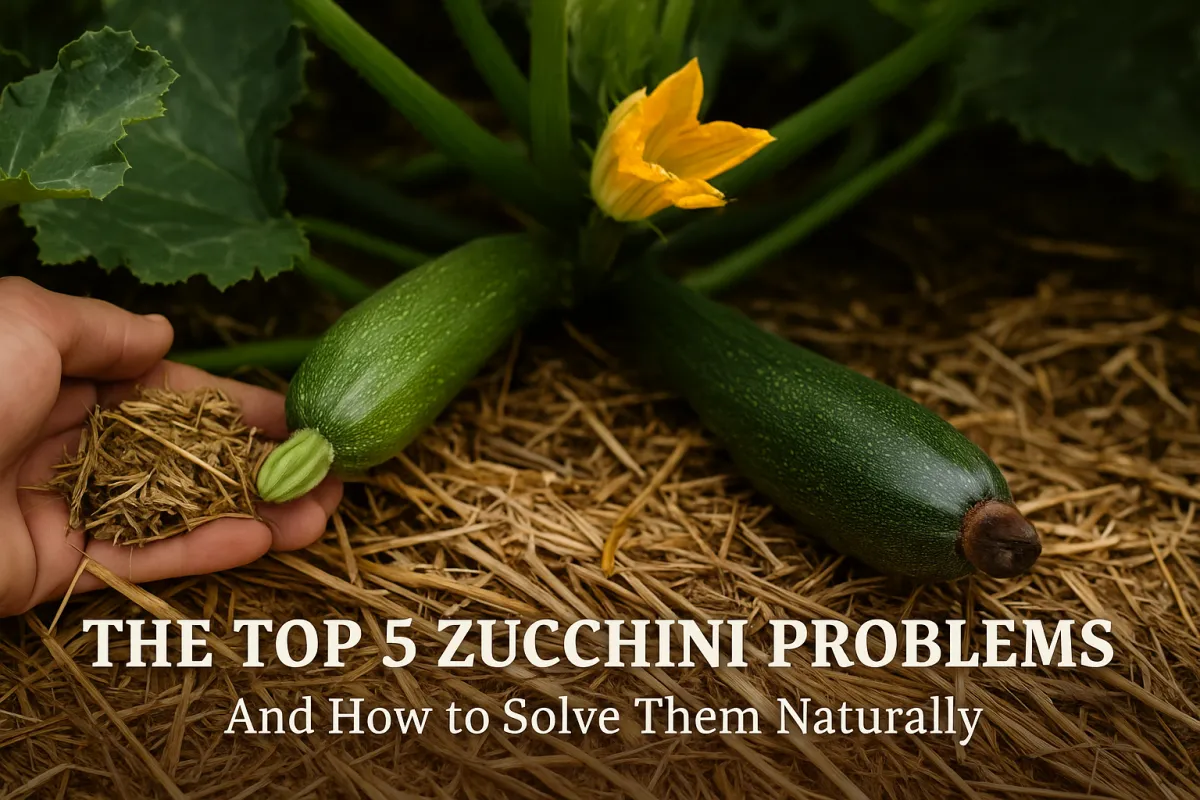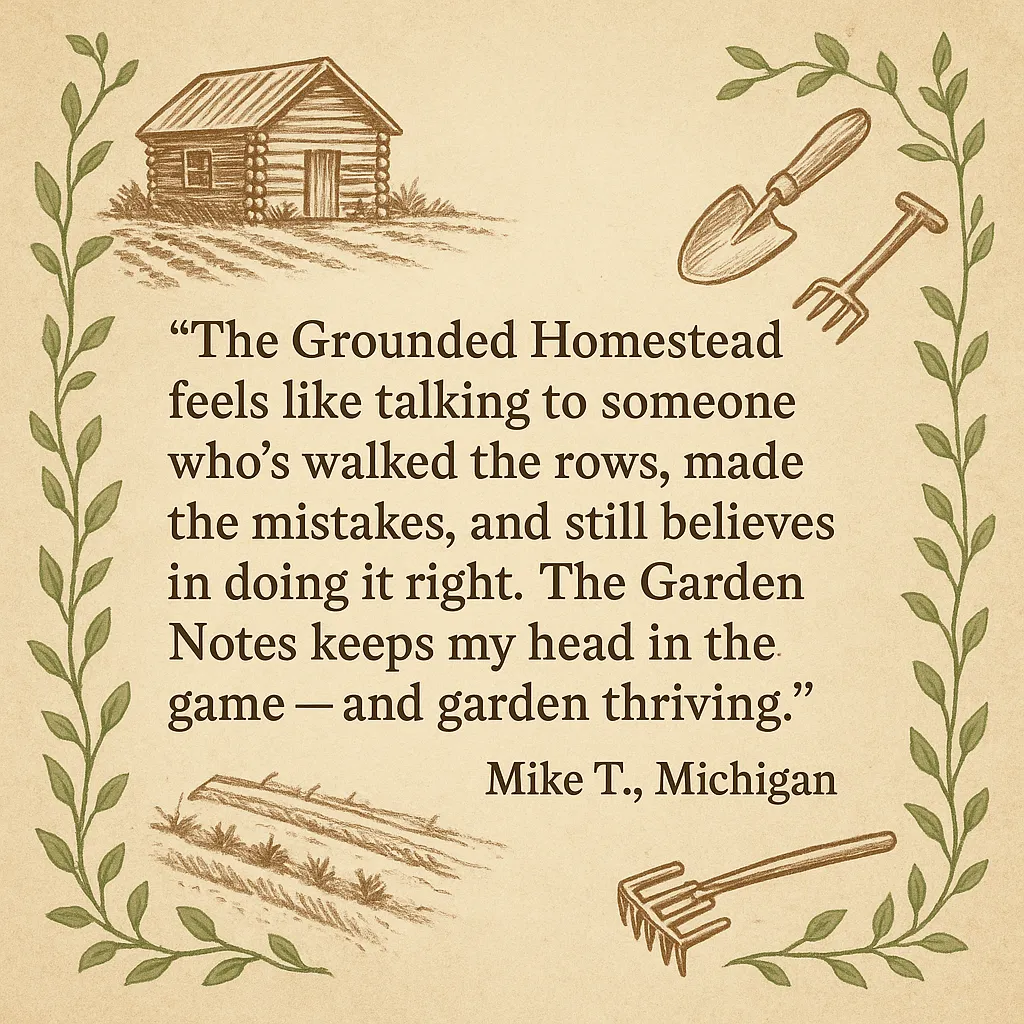
The Top 5 Zucchini Problems—And How to Solve Them Naturally
The Top 5 Zucchini Problems—And How to Solve Them Naturally
I used to think zucchini was foolproof. One of those “plant it and forget it” crops. But my second season taught me otherwise—fast. One morning, I walked out to find my once-thriving plants looking like they'd had the life sucked out of them. Rotting fruit. Wilted leaves. Powdery splotches. That’s when I realized: zucchini might be easy to grow, but keeping it healthy takes attention.
If you’ve run into the same headaches—or want to avoid them altogether—this post walks you through the top 5 problems that wreck zucchini plants and how to fix each one naturally, without reaching for the chemicals. These tips are what I use here at The Grounded Homestead, passed down from trial and error, a little reading, and a lot of Grandma’s wisdom.
1. Blossom-End Rot
What it looks like:
Dark, sunken spots on the blossom end (not the stem) of your zucchini. The fruit looks like it's rotting from the tip inward.
What causes it:
It’s not a disease—it’s a calcium imbalance. Usually caused by inconsistent watering, which blocks calcium from reaching the fruit. Overdoing nitrogen fertilizers can make it worse.
How to fix it naturally:
Water evenly—deep, consistent moisture is the key. Don’t let the soil dry out and then drench it.
Add mulch to regulate soil moisture and temperature.
Avoid high-nitrogen fertilizers that promote leafy growth at the expense of fruit.
In early spring, mix in crushed eggshells or garden gypsum to add slow-release calcium.
Zone tip:
In hotter climates (Zone 8+), dry spring spells often trigger blossom-end rot earlier. Get ahead of it with mulch and regular watering from the start.
Grandma’s tip:
“Don’t water with a fire hose after lettin’ it dry out for a week. Plants like rhythm—just like folks.”
2. Powdery Mildew
What it looks like:
A white, powdery coating that starts on lower leaves and spreads upward. Leaves may yellow and shrivel over time.
What causes it:
High humidity, poor airflow, overcrowding, and watering leaves instead of soil.
How to fix it naturally:
Space plants properly and prune crowded leaves to increase airflow.
Water at the soil line—not on the leaves—and do it early in the day.
Spray weekly with a homemade baking soda mix:
1 tbsp baking soda + ½ tsp liquid soap in 1 gallon of water.Reapply after rain or heavy dew.
Zone tip:
In humid zones like 7b and up, start spraying preventatively—don’t wait for white spots to show up.
Product tip:
A pressurized garden sprayer makes this task faster, cleaner, and more consistent. Worth every penny.
3. Squash Vine Borer
What it looks like:
Healthy-looking zucchini suddenly wilts during the day. At the base of the stem, you’ll see frass—orange-brown, sawdust-like droppings. That’s your clue: a vine borer is tunneling inside.
What causes it:
Adult moths lay tiny rust-colored eggs at the stem base. Once hatched, larvae burrow in and hollow out the stem.
How to fix it naturally:
Wrap the lower 6 inches of the stem with foil or pantyhose to block egg laying.
Cover plants with floating row covers until they flower—then uncover for pollination.
Check stems daily and remove eggs by hand.
If a plant is already infected:
Slit the stem lengthwise with a sharp knife, remove the larva, bury the stem with soil, and water deeply. The plant may reroot above the damage.
Zone tip:
In Zones 5–7, vine borers usually hit late June to early July. Mark your calendar to start inspecting stems.
Grandma’s tip:
“If you catch it early, you can save it. Blink twice and that borer will gut it like a fish.”
4. Poor Fruit Set
What it looks like:
Plenty of flowers but no fruit. Or tiny zucchini start growing, then shrivel and fall off.
What causes it:
Usually poor pollination. Zucchini have separate male and female flowers. If bees aren’t around (or weather’s cold and wet), female flowers don’t get pollinated.
How to fix it naturally:
Hand-pollinate: Use a soft paintbrush or cotton swab to transfer pollen from male to female flowers.
(Tip: Do it in the morning when flowers are fully open.)Attract pollinators with borage, nasturtiums, calendula, and other pollinator-friendly flowers.
Avoid broad-spectrum pesticides—they’ll scare off your helpers.
Zone tip:
In cooler zones (5–6), early spring gardens often suffer from low pollinator activity. Hand-pollination is the fix.
Visual aid:
Download the “How to Hand-Pollinate Zucchini” printable to keep in your garden journal.
5. Wilting Leaves
What it looks like:
Zucchini leaves droop dramatically—sometimes mid-day, sometimes all day.
What causes it:
Let’s break this into three possibilities:
Heat stress — Totally normal. Plants wilt under intense sun but bounce back by evening.
Overwatering/root rot — Constantly soggy soil suffocates roots.
Squash bugs — Sucking pests that weaken the plant and carry disease.
How to fix it naturally:
Mulch deeply and water early morning—not every day, only when top 1–2 inches are dry.
Check for squash bugs daily. Crush egg clusters and hand-pick adults into a jar of soapy water.
Spray neem oil or insecticidal soap only as needed—and target pests directly.
Invite beneficial insects with wildflowers or insect habitat bundles.
Grandma’s tip:
“A good garden isn’t what you plant—it’s what you notice. The more you watch, the more you’ll catch.”
✅ Weekly Watch List: Stay Ahead of Zucchini Trouble
Print this. Tape it to your shed wall. Walk your garden each Saturday morning with a coffee in hand and check off the list.
☐ Look under leaves for pest eggs or mildew
☐ Water deeply—but only when needed
☐ Prune thick center growth for better airflow
☐ Watch for early blossom-end rot
☐ Hand-pollinate if flowers outnumber fruit
Final Thoughts
Zucchini might not demand much—but it responds to the kind of attention that comes with care. If you’re consistent, observant, and just a little stubborn, you’ll come out ahead. Most of the problems you’ll face can be caught early, handled naturally, and avoided next time.
I don’t use chemicals out here—and I don’t miss them. With the right rhythm, a little grit, and a good compost pile, your zucchini will grow strong.
“Tend the work in front of you. Be faithful in the small things—and the harvest will come.”


Facebook
Instagram
X
Youtube